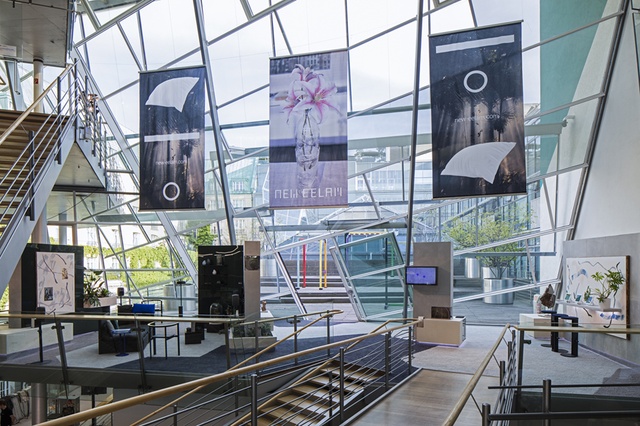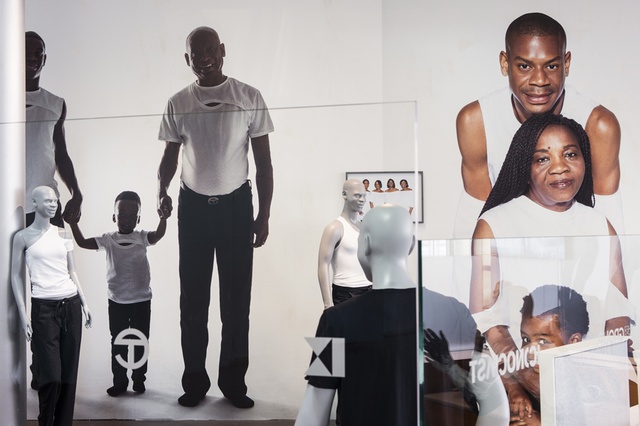David Joselit and Hanna Magauer on the 9th Berlin Biennale Short Cuts: Berlin Biennale 9
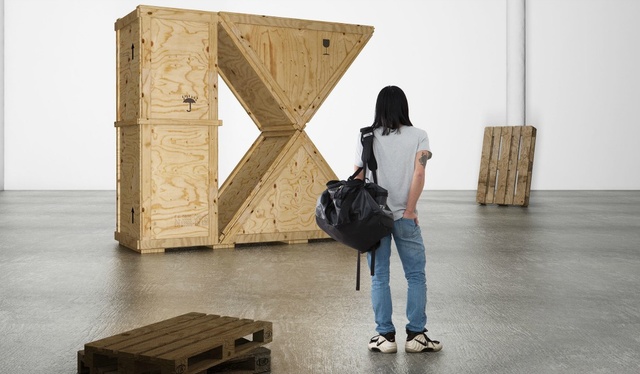
If there is a subtext to TZK's poetry issue, it is one linking the new “poetics” that has appeared in critical discourse of late (as a language characterized by an immediate, personal tone) to the protocol of contemporary global capitalism (e.g., the use of English, the familiar “you” of neoliberalism). This intimate voice is not however, as some have claimed, necessarily an apolitical one. Rather, perhaps it is precisely in this language that the crisis of contemporary self-hood can be seen – a language that was at the core of this summer’s Berlin Biennale 9, curated by DIS.
Here, art historians David Joselit and Hanna Magauer take stock of this exhibition, asking what signal, amid the stream of mediagenic poetics and visual branding, can be separated from the noise.
David Joselit: Four Theses on Branding
Walking around my Manhattan neighborhood, it occurs to me that something like three generations of frozen yogurt stores have come and gone in the past ten years. Branding, I say to myself, isn’t so easy. A brand commands attention by producing and widely disseminating an instrumentalized image. In an attention economy, branding is relevant to art because it exemplifies how images create collective identifications, if not quite genuine publics, through their representation of products or experiences. Many dimensions of branding are invisible in the final product itself: ranging from initial market research to data on consumption patterns. Consequently, to grasp its complexities requires much more than appropriating the rhetorical surfaces of advertising and commercial design. Branding is not a style, in other words, but rather an operation, which includes both an initial gambit for capturing attention and a long-term, always precarious effort to maintain “customer loyalty.” To take on such procedures, as so many of the artists in this year’s Berlin Biennial (bb9) have done, is a pressing and exhilarating problem – especially for a generation who grew up creating multiple profiles online. But too often the works included in bb9 address only the surfaces of branding – its style – rather than its deep structure.
Fashion does branding by generating perpetual novelty – a procedure dear to the art world, as well. But over the past hundred years, one can track at least four aesthetic models whereby artists mobilized what we now recognize as the brand. They include: (1) The ambition of early twentieth-century avant-garde visual culture to assist in transforming political subjectivity by branding revolution, as in the efforts of Aleksandr Rodchenko, Varvara Stepanova, and Liubov Popova, among many others who aimed to abandon the special preserve of fine art in order to build new forms of advertising, fashion, and theater adequate to the ideals of the USSR. (2) The artist as celebrity, who produces a recognizable “product line” (silk-screened flowers, “Spot” paintings, “superflat” riffs on Japanese comics, and inflatable toys rendered in stainless steel) – intended to create value not through the traditional mechanism of scarcity but through media saturation. Andy Warhol is the relevant historical reference here (though Soviet or Chinese socialist realism accomplished an analogous elision of fine art and mass culture without a corresponding fixation on the personality of the artist). This tradition has been enthusiastically taken up by myriad others since the 1960s, including Damien Hirst, Takashi Murakami, and Jeff Koons. (3) Simulation of commercial language by artists of the 1980s (whose relevance to the post-Internet practices on display in Berlin is deeply repressed), such as Barbara Kruger’s and Jenny Holzer’s trenchant mobilizations of advertising rhetoric, which were meant to “subvert” branding by creating expectations for an affirmative message only to deliver a critical one instead. And also: (4) strategies for garnering attention – and thus currency – in our contemporary experience economy merely by remaining physically present (rather than appearing as a simulated or mediated image), as exemplified by Marina Abramovic, who demonstrated that performance art and Hollywood need not be in contradiction with one another in an era when screen-addicted people seem desperately hungry for face-to-face contact. I offer this genealogy not so much to criticize the DIS collective’s decision to ignore such predecessors, but rather to develop a critical perspective from which to evaluate their assertion of art’s convergence with such consumer-oriented operations as branding. I want to take seriously the idea that art can engage productively with branding, and to question how such engagement is staged in “The Present in Drag,” as this biennale is titled. In fact, DIS, along with other artist “corporations” such as e-flux, Reena Spaulings, and K-Hole, furnish an additional model for aesthetic branding: (5) structuring art practice as an infrastructure to provide a network of platforms supporting a wide variety of activities including exhibitions, publishing, fashion, performance, and even traditional object making.
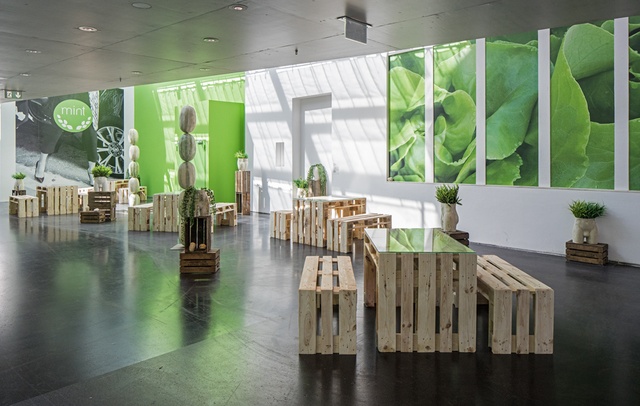 Debora Delmar Corp., "MINT," Akademie der Künste, Berlin Biennale 9, 2016, installation view
Debora Delmar Corp., "MINT," Akademie der Künste, Berlin Biennale 9, 2016, installation view
What is most disappointing about the Berlin Biennial is not DIS’s evasion of history, which may in fact be an ethical decision to sideline the kind of historicizing account of contemporary art that privileges critique of commercial structures of experience in favor of, for instance, the exploration of their affective properties, or perhaps a self-conscious provocation at a moment when so many artists seem to believe that since the Internet functions as an infinite archive, history has become irrelevant. Rather, what I find disturbing is the shallow engagement with branding that so many exhibiting artists demonstrate, where the “look” of corporate speech is mimetically reproduced in the absence of any deeper engagement with its quasi-imperial structure of accumulating and sustaining attention over time.
Take, for example, Debora Delmar Corp.’s “MINT” (2016), a juice bar installed within Berlin’s Akademie der Künste, one of five primary sites across which bb9 is staged. The work aims at making visible the contradiction between first-world consumption of overpriced yet supposedly hyper-nutritious foods and the fact that such luxury health products almost inevitably contribute to the often exploitative dynamics of trade with the developing world (the name “MINT,” consequently, is not just a reference to the kind of “green juice” for sale in Delmar Corp.’s café, but an acronym for Mexico, Indonesia, Nigeria, and Turkey). The implication is that to make these health foods, so-called green corporations are nevertheless paying suppliers to divert raw materials for end products that the vast majority of the developing world’s citizens could never afford.
While Delmar’s intentions here are -worthy, the work’s visual resolution is banal and amateurish compared to the actual branding of fast food chains everywhere (“healthy” ones included). It is hard to compete with such forms of commercial art – ranging from store design to fashion – that are so much more sophisticated in their modes of aesthetic persuasion than artists’ pale imitations of them. Delmar’s gesture toward verisimilitude leaves us on the level of branding’s surface – it’s style, rather than its procedural structure. This is because such simulations are divorced from the exigency of an actual brand’s imperative to continuously respond to changing market conditions. The brand, in short, is a dynamic organism, not an idiom to be appropriated. In this regard, it seems to me that the only truly successful corporate brand in the Biennial is DIS itself; and this is largely because it has submitted itself to market testing in the art world through, among many other things, the critical debates that are taking place in these pages.
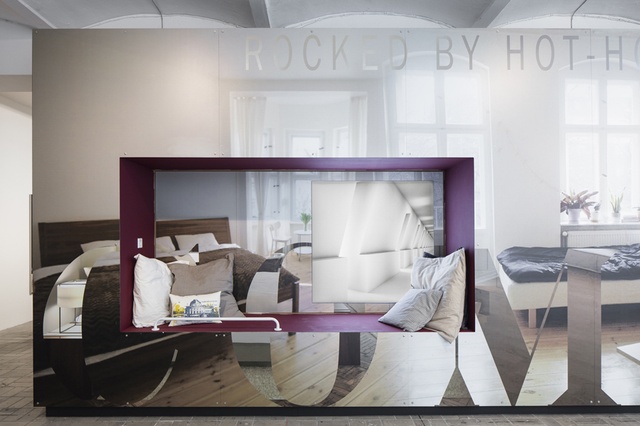 åyr, "Architecture," Kunst-Werke, Berlin Biennale 9, 2016, installation view
åyr, "Architecture," Kunst-Werke, Berlin Biennale 9, 2016, installation view
There is, however, an important additional model that is much more convincingly presented in “The Present in Drag”: (6) The subject as brand, whose relation to herself is mediated by the imperative toward self-improvement and self-perfection (what Michel Foucault identified as the entrepreneurship of oneself, and which now might be more aptly understood, per DIS, as the curatorship of oneself). Such forms of self-enrichment are deeply imbricated in contemporary forms of over-identification between persons and products. These two dynamics – self-enrichment and consumer identification – establish a kind of feedback loop whose alternation of alienation and incorporation, self-as-surface, and body-as-malleable-matter is eloquently captured in the “drag” of the Biennial’s title. It is the slick relentlessness of this vicious (or virtuous) cycle of accelerating consumption and escalating subjective value that marks a difference from earlier explorations of the subject as brand in, for instance, the politicized figure of Reena as rendered by (the novel and related projects) “Reena Spaulings.”
A range of experiences of self-becoming-brand are represented by artists in the exhibition: Cécile B. Evans establishes a multi-dimensional character, HYPER, as a cypher of corporate personhood in “What the Heart Wants” (2016); John Rafman represents animals devouring each other in a range of sculptures collectively titled “L’Avalée des avalés” (The Swallower Swallowed, 2016) and an Oculus Rift VR presentation, “View of Pariser Platz” (2016); and Korakrit Arunanondchai/Alex Gvojic establish cycles of evolution and devolution between human and animal forms, framed by consumerism in their 2016 film “There’s a word I’m trying to remember, for a feeling I’m about to have (a distracted path toward extinction).” Here are modes of embodied “drag” that establish specific affective relationships between digital animation and animality, self-possession and self-cannibalization. It is precisely in such questions of what it means, as a person, to become a dominant and dominating image – i.e., a brand – that art is relevant. It can explore the imperative to curate oneself, to construct subjectivity as an aggregation of images.
Hanna Magauer: Mantras of the Present
It has almost been forgotten that the building DIS selected as the main site for their Biennale once caused fierce debate: Günter Behnisch’s design for the Akademie der Künste having been entirely out of step with the “critical reconstruction” policy decreed by the planning department of the reunified Berlin, which aimed to contrast the “American office city.” Even today, empty building sites continue to bring forth austere marble façades, fully in keeping with Prussian style. Now, in an ironic turn of events – whether intentional or not – a cluster of US artists has reframed Behnisch’s glass halls on Pariser Platz as an exhibition venue and conference center. Rather than repeating the “critical” Biennial formula, DIS has outfitted the AdK with corporate aesthetics. Such aesthetic engagement is clear upon entering the building’s foyer, where, for example, the New York designer Telfar installed a pop-up shop (selling shirts inscribed with the word Publikum); or at the cafe stand, which stocked €5 detox green juice (Deboara Delmar Corp., “MINT,” 2016); and in Timur Si-Qin’s Zen garden (“A Reflected Landscape,” 2016), which brings to mind the planted greenery typical of an insurance company lobby. Also in the AdK foyer, lightboxes display a burning Trump hat (Torbjørn Rødland) and looks from Hood By Air’s runway, among images by others; meanwhile, Jon Rafman’s Oculus Rift VR animation (“View of Pariser Platz,” 2016) accessed on the building’s fourth floor balcony allowed you to look out across at the horse-drawn carriages atop the Brandenburg Gate and watch this stronghold of tourism dissolve into a somber Armageddon fantasy.
As with every Berlin Biennale, the focus is invariably on one thing: Berlin, and this time: the city’s identity crisis. Berlin’s “first days” [3] are long gone and have been marketed both often and extensively. The previous two editions of the Berlin Biennale – Juan Gaitán, in 2014, looking to the periphery via the Ethnological Muesum in Dahlem and Artur Zmijewski’s direct, placard-like Occupy actions at the KW Institute in 2012 – made it clear that the curatorial strategy of mobilizing criticality in the public sphere has worn thin due to constant overuse. DIS thus positions its edition, titled “The Present in Drag,” as a direct antithesis to the propositions of its predecessors. In place of activists painting protest banners, a young woman in business attire appears on screens in entrance hall of Kunst-Werke (the biennale was staged across five sites in all), drawing mind maps on a whiteboard. Meanwhile, the bb9 website proclaims, “It’s exactly what you expect,” which one might take to mean, here, a stagnant Biennale on the one side – with its nostalgia for the ’90s as mere grist for the real estate and art-value-creation mill – and an art-collective-as-corporation on the other side, squatting the aesthetic output of the market.
And indeed, long-held expectations are fulfilled in the closest possible sense. And so it’s surprising at first that the Biennale was even able to occasion the kind of indignation found in Jason Farago’s review in the Guardian, “Welcome to the LOLhouse” [4] , in which the melancholy and camp of the works in bb9 are confused with a lack of seriousness. On closer inspection, the propositions made by the majority of artists here are in fact not categorically new – and neither are they categorically “anti-critical” or positioned against “political art,” even if the omnipresence of Pop aesthetics might engender suspicions otherwise. At the AdK, Simon Fujiwara constructed a Museum of German Happiness (“Happy Museum,” 2015), an arrangement of various objects, ranging from a meticulous home kitchen waste disposal system to a garden gnome to pieces of rotting white asparagus (greetings from Dieter Roth!) neatly lined up alongside limited edition Kinder chocolates featuring childhood photos of the German men’s football team (about which, earlier this summer, Pegida & co. was led to make racist comments). The duo Korpys/Löffler, meanwhile (appearing in the Feuerle Collection, Berlin’s newest art bunker), interrogate architectures of power, taking as their example Coop Himmelb(l)au’s European Central Bank building in Frankfurt. Back at AdK, Christopher Kulendran Thomas, deploying a start-up with a matching promo film, outlines a model of citizenship in the era of ultra-mobility; and Simon Denny’s presentation (at a third venue) of business models such as those of Ethereum and Bitcoin places an almost Utopian hope in new corporate forms (which, in the case of Ethereum’s block-chain plan, promise something akin to a free, incorruptible Internet).
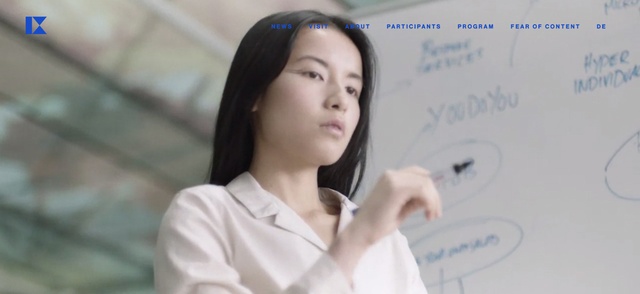 bb9.berlinbiennale.de
bb9.berlinbiennale.de
“Your politics sometimes feel like a metro ad, sometimes like a mass movement, and sometimes like a sham,” declares one of DIS’s introductory texts – and the selection of works conveys precisely this. Rather than yielding a coherent image from which it would be possible to read (à la Fargo) something resembling an apathy towards history, the various positions are here subsumed within an over-present curatorial framework, a (digital, commercial) style that binds the Biennale together. This is reinforced not only by the ubiquitous (and certainly fun) promo clips, the website, and the press kit, but rather and principally by an invocation of the “contemporary,” of the contemporary visitor-subject – an invocation that is conspicuously made in the didactic materials accompanying the artworks in the hall. At the beginning of each station, these texts address visitors with an indefinite, generalized “you” (one also typical of start-up rhetoric): “You’re a sharp critic of the sharing economy – while waiting for your Uber.” “You’re a Marxist, but deep down you respect Angela Merkel.” “In this age of total speculation, you can’t even see a present from which to imagine a future.” Like a mantra, they conjure up the conflicts of a “contemporary” and of a “generation,” which allegedly encompasses visitors and artists alike. In a this fashion, these observations read as self-fulfilling prophecies. I can’t help to ask myself: Must you find yourself in these texts? Do they not equally/rather speak of the ever-more-present impulse to define a new generational identity, as actually characterizing an entire generation? Does such rhetoric not generalize the extremely specific cultural contexts with which some works are engaged? The curatorial set-up demands the viewer to assume a position on one side or the other of a binary: identification or non-identification, only to mute the question in representation of a certain “lifestyle.” The markedly personal mode of address is used to declare a kind of universality, used to relocate any conflict into the realm of the subjective. [5] One could imagine to replying with a different form of address: “You’re part of a network that, though active mainly between New York and Berlin, LA and Frankfurt, takes its perspective to be a global one.” “You’re confronted with growing political polarization while taking refuge in the inclusivity rhetoric of the art world.” (Characterizing this perspective as simply “American” or “expat,” as is so often done of late, would again be an all-too-easy generalization.)
With the dominance of the curatorial (– can the role of the star-curator today only be fulfilled by the artist?), this Biennale strategically constructs a coherent look. Not always does this help the reception of the individual works, however, nor does it help the matters they address (crypto-tech companies gathering data about your life, emotion as a commodity, etc.). And still, it is certainly apparent that DIS has been successful with this toolkit, as it is at those very locations whose aesthetic and architectural surfaces bear witness to their own institutional contradictions that this Biennale – directly through its resolute style – succeeds in creating an exaggeration of public space, a perversion of financialized structures. At the ESMT (European School of Management and Technology), formerly the offices of East Germany’s Council of State, the Biennale presents works from Simon Denny, Katja Novitskova and GCC, penetrating the expanse between a peace dove mosaic and screens showing the Frankfurt Stock Exchange and the site of Berlin’s under-reconstruction Palace before the windows – the latter a reminder of Berlin’s own desire to be liberated from (historical) conflict. Likewise in the Akademie der Künste – which here acts as an architecture of power, as a fair or congress hall (site of much bb9 programming) – the exhibition carries a reminder that a Biennale is a festival. Particularly in comparison with Zurich’s Manifesta, taking place simultaneously, one finds here, at the very least, the possibility of giving a resolute answer to the perennial Biennale circus.
Translation: Matthew Scown
9th Berlin Biennale for Contemporary Art, June 4 to September 18, 2016.
Notes
| [1] | Christopher Kulendran Thomas, "New Eelam," Akademie der Künste, Berlin Biennale 9, 2016, installation view |
| [2] | Telfar, “Retrospective,” 2016, Akademie der Künste, Berlin Biennale 9, installation view. |
| [3] | See Ulrich Gutmair, Die ersten Tage von Berlin. Der Sound der Wende, Stuttgart 2013. |
| [4] | Jason Farago, “Welcome to the LOLhouse: How Berlin’s Biennale became a slick, sarcastic joke,” The Guardian, June 13, 2016 https://www.theguardian.com/artanddesign/2016/jun/13/berlin-biennale-exhibition-review-new-york-fashion-collective-dis-art |
| [5] | Cf. Texte zur Kunst, 101, 2016 |

